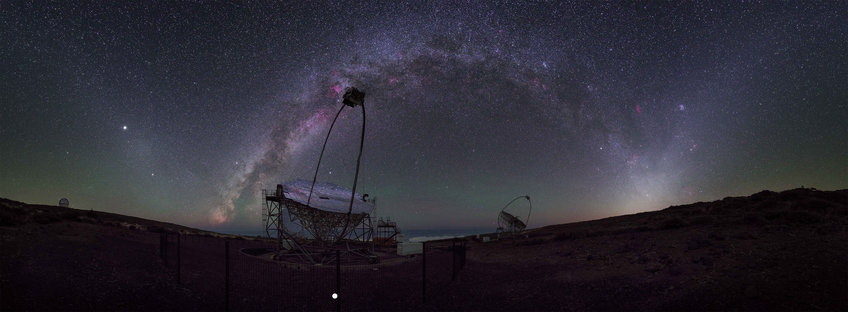Telescopes search for dark matter
Dark matter particles could leave traces in gamma spectrum
The Magic telescopes on La Palma are on the hunt for dark matter. For 233 observational hours, their cameras were pointed at the center of the Milky Way, our home galaxy. Scientists suspect a particularly large accumulation of non-luminous, invisible matter there. However, the search yielded no results. Even if the sensation of a dark matter discovery has failed to materialize, the observations will help to characterize the properties of dark matter more precisely – and to refine the underlying theoretical models.

At first glance, it may seem paradoxical to search for dark matter with telescopes. Usually, these instruments measure light, for example radio waves, infrared radiation or optical light. Dark matter is characterized by the fact that it does not emit light, i.e. it does not glow. Nevertheless, its existence can leave traces in the form of gamma radiation - and this is where the Magic telescopes come into play: They detect Cherenkov radiation, which is produced when gamma particles hit molecules in the Earth's atmosphere.
Researchers assume that dark matter particles are very heavy. When they collide, they may produce features of high-energy radiation in the gamma spectrum. And if that happened, it should be possible to measure these with the Magic telescopes. The very high sensitivity of the Magic system at such high energies is crucial, as the mass of the dark matter particles – and thus the light that may be produced in their rare interactions – may well be around those energies.
Possible clues: lines in the gamma spectrum
In order to be able to distinguish any possible signal from dark matter interactions from already known astrophysical phenomena, the Magic scientists focused on gamma-ray lines – light emitted within a specific, narrow range of energies. Like the human fingerprint, such spectral lines are unique: they are the indication of interactions of particles much heavier than the known elementary particles.
Even though the Magic telescope observations have not detected any traces of dark matter: The measurements nevertheless contain important clues. The lack of detection can be converted into upper limits on the maximum possible interaction strength between dark matter particles, which strongly depend on the density of dark matter particles we expect at the center of our Galaxy. Therefore, the scientists tested the data for various assumptions. Moreover, the result helps to further constrain possible properties of dark matter particles and the underlying models.
In the future, the applied technology will enable much more precise searches - with Magic instruments and the next generation of telescopes. Currently, several Large Size Telescopes (LST) are being built at the observatory on the Canary Island of La Palma, next to the Magic telescopes. These are part of the CTA project, which will build about 100 gamma-ray telescopes in Chile and La Palma over the next few years.
